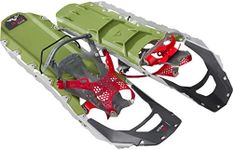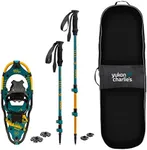Buying Guide for the Best Snow Shoes For Men
Choosing the right pair of snowshoes is essential for enjoying your winter adventures. Snowshoes are designed to help you walk on snow without sinking, and the right pair can make a big difference in your comfort and performance. When selecting snowshoes, consider the type of terrain you'll be exploring, your weight, and the kind of activities you'll be doing. Here are some key specifications to help you make an informed decision.SizeThe size of the snowshoes is crucial because it affects your ability to stay on top of the snow. Snowshoes come in different lengths and widths, and the right size for you depends on your weight (including any gear you’ll be carrying) and the type of snow you’ll be walking on. Larger snowshoes provide better flotation in deep, powdery snow, while smaller snowshoes are more maneuverable and better for packed trails. If you plan to hike in deep snow, opt for larger snowshoes. For packed trails or icy conditions, smaller snowshoes will be more efficient.
Frame MaterialThe frame material of snowshoes can affect their weight, durability, and performance. Common materials include aluminum, plastic, and composite. Aluminum frames are lightweight and durable, making them a popular choice for most users. Plastic frames are often more affordable and can be very durable, but they might be heavier. Composite frames offer a balance of durability and weight. If you’re looking for a lightweight option for long hikes, aluminum is a good choice. For rugged terrain, consider composite or plastic frames for added durability.
BindingsBindings are what secure your boots to the snowshoes, and they play a significant role in comfort and ease of use. There are different types of bindings, including strap bindings and ratchet bindings. Strap bindings are versatile and can fit a variety of boot sizes, but they might take longer to put on and take off. Ratchet bindings are quicker to adjust and provide a more secure fit, but they might not be as versatile. If you need to frequently take your snowshoes on and off, ratchet bindings might be more convenient. For a more customizable fit, strap bindings are a good option.
TractionTraction is important for maintaining stability and preventing slips, especially on icy or steep terrain. Snowshoes come with different types of crampons and traction systems, such as toe crampons, heel crampons, and side rails. Toe crampons provide grip at the front of the snowshoe, heel crampons help with descents, and side rails offer additional stability on uneven terrain. If you plan to hike on icy or steep trails, look for snowshoes with aggressive traction systems. For flat or rolling terrain, basic traction will suffice.
Heel LiftHeel lifts, also known as climbing bars, are a feature that can make uphill hiking easier by reducing calf strain. They are metal bars that can be flipped up under your heels to provide extra support on steep ascents. This feature is particularly useful if you plan to do a lot of climbing. If your snowshoeing adventures will take you up steep hills, look for snowshoes with heel lifts. For flat or gently rolling terrain, this feature may not be necessary.






















